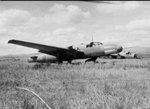Part one. (Anti-shipping missile carrier)
The Japanese I-Go-1-Ko Radio controlled anti-shipping missile. Intended to be carried by a Ki-109 carrier aircraft-ten were built but never saw operational use. Weighed 3,086lb with a 1,764lb warhead and powered by a Tokuro rocket providing 529lb of thrust for 75 seconds it was expected to attain a speed of 342 mph. The rocket fired 1.5 seconds after launch. Tests were conducted over a range on Lake Biwa, near Koyto, with targets being rock formations on the edge of the Lake. Good results justified further production, but by this stage the war was lost.


The Japanese I-Go-1-Ko Radio controlled anti-shipping missile. Intended to be carried by a Ki-109 carrier aircraft-ten were built but never saw operational use. Weighed 3,086lb with a 1,764lb warhead and powered by a Tokuro rocket providing 529lb of thrust for 75 seconds it was expected to attain a speed of 342 mph. The rocket fired 1.5 seconds after launch. Tests were conducted over a range on Lake Biwa, near Koyto, with targets being rock formations on the edge of the Lake. Good results justified further production, but by this stage the war was lost.








